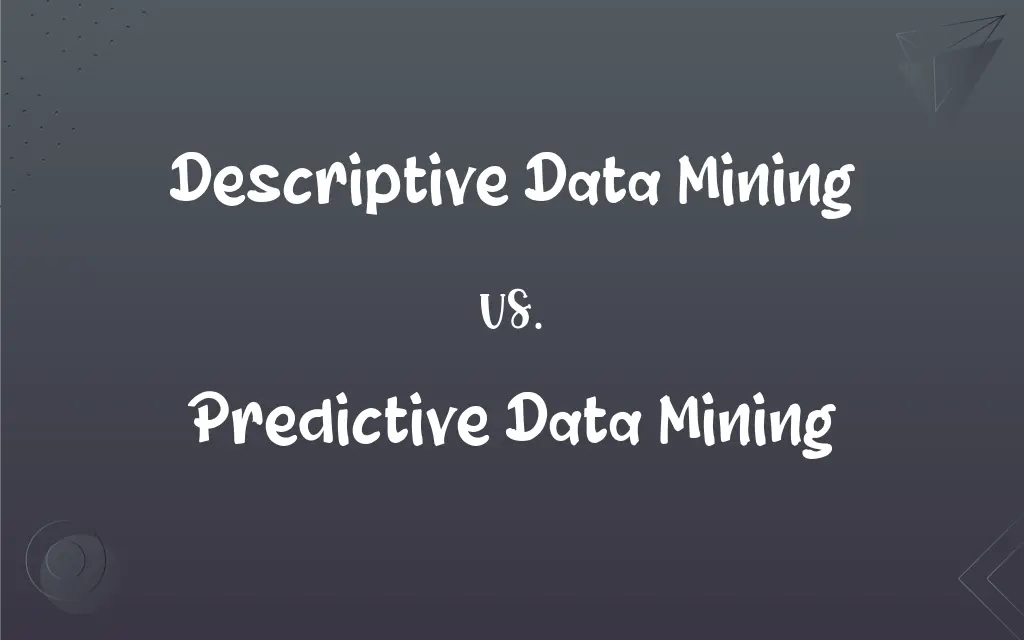Descriptive Data Mining vs. Predictive Data Mining: What's the Difference?
Edited by Aimie Carlson || By Janet White || Published on February 25, 2024
Descriptive data mining uncovers patterns to understand past behavior; predictive data mining uses that information to forecast future outcomes.

Key Differences
Descriptive Data Mining focuses on understanding past behaviors by finding patterns and relationships in historical data. It helps in summarizing the data into meaningful information. In contrast, predictive data mining uses the patterns identified by descriptive analysis to model and forecast potential future events. It is more about making predictions based on known properties.
Descriptive Data Mining provides insights into what has happened. For example, it might analyze customer purchase history to understand buying trends. Predictive Data Mining technique uses these insights to anticipate future trends or behaviors. For instance, it might predict future purchase behaviors of customers based on their history.
Descriptive Data Mining often involves data summarization, clustering, and association. It helps businesses understand their current situation. Predictive Data Mining employs algorithms like regression and classification to predict future scenarios. It is more about applying models to forecast future outcomes.
Descriptive Data Mining is crucial for businesses to make sense of large volumes of data and draw meaningful conclusions. Predictive Data Mining takes these conclusions a step further by applying them to predict future trends and behaviors, thereby aiding in strategic planning.
Descriptive Data Mining is about the interpretation of historical data to better understand changes that have occurred in a business. Predictive Data Mining aims to use this historical data to predict future occurrences, helping in decision making and planning.
ADVERTISEMENT
Comparison Chart
Purpose
To understand and summarize past data
To predict future events or trends
Techniques
Clustering, Association, Summarization
Regression, Classification, Time Series Analysis
Focus
Past and current data patterns
Future outcomes and trends
Utility
Understanding what happened
Forecasting what might happen
Outcome
Descriptive insights
Predictive models
ADVERTISEMENT
Descriptive Data Mining and Predictive Data Mining Definitions
Descriptive Data Mining
Interpreting large volumes of data to identify trends.
A business uses descriptive data mining to understand regional sales trends.
Predictive Data Mining
Creating models to forecast potential scenarios.
An online retailer uses predictive data mining to predict future customer buying behavior.
Descriptive Data Mining
Clustering and associating data to reveal insights.
Descriptive data mining helps a supermarket to group customers based on buying habits.
Predictive Data Mining
Applying algorithms to predict outcomes.
A bank uses predictive data mining to assess the risk of loan defaults.
Descriptive Data Mining
Uncovering hidden patterns in historical data.
Through descriptive data mining, a company discovers a correlation between customer age and product preference.
Predictive Data Mining
Using statistical models to forecast future trends.
Predictive data mining is used to estimate future sales based on current trends.
Descriptive Data Mining
Analyzing large datasets to find patterns and relationships.
A retailer uses descriptive data mining to identify the most popular products in each season.
Predictive Data Mining
Utilizing past data to make informed predictions.
A healthcare provider uses predictive data mining to anticipate patient admissions.
Descriptive Data Mining
Summarizing past data to make it understandable.
Descriptive data mining reveals that sales increase during holiday seasons.
Predictive Data Mining
Forecasting future events based on historical data.
Predictive data mining predicts stock market trends based on past data.
FAQs
What is descriptive data mining?
It's the process of analyzing historical data to find patterns and understand past behavior.
What is predictive data mining?
Predictive data mining uses historical data to make predictions about future events.
How do descriptive and predictive data mining differ in purpose?
Descriptive focuses on understanding past data, while predictive aims at forecasting future outcomes.
What techniques are typical in predictive data mining?
It often involves regression, classification, and time series analysis.
Is descriptive data mining enough for business decision-making?
It provides valuable insights but doesn’t predict future trends, which is often crucial for decision-making.
What techniques are used in descriptive data mining?
Techniques like clustering, association, and summarization are common.
Which is more complex, descriptive or predictive data mining?
Predictive data mining is generally more complex due to its forecasting nature.
Can predictive data mining work without descriptive data mining?
Typically, no. Predictive analysis often relies on the insights gained from descriptive analysis.
What role does AI play in predictive data mining?
AI enhances predictive analytics by providing more accurate and complex modelings.
Can predictive data mining be used in risk management?
Yes, it’s commonly used to predict risks and uncertainties in various sectors.
Can small businesses benefit from predictive data mining?
Yes, it can help in forecasting sales, customer demand, and more.
What industries benefit from descriptive data mining?
Retail, finance, healthcare, and marketing, among others.
Does descriptive data mining require advanced algorithms?
Not necessarily, it often relies on simpler statistical methods.
How does descriptive data mining assist in customer relationship management?
It helps understand customer preferences and behavior to improve service and engagement.
Can predictive data mining guarantee accurate future predictions?
No, it provides probabilities and trends based on available data, not certainties.
Is historical data always necessary for predictive data mining?
Yes, it relies on historical data to make future predictions.
How does predictive data mining impact financial forecasting?
It helps in forecasting market trends, stock performances, and economic shifts.
What skills are needed for effective descriptive data mining?
Skills in statistics, data analysis, and pattern recognition are important.
Is predictive data mining useful in healthcare?
Yes, for predicting disease outbreaks, patient admissions, and treatment outcomes.
How does descriptive data mining help in marketing?
It helps identify customer behavior patterns, aiding in targeted marketing strategies.
About Author
Written by
Janet WhiteJanet White has been an esteemed writer and blogger for Difference Wiki. Holding a Master's degree in Science and Medical Journalism from the prestigious Boston University, she has consistently demonstrated her expertise and passion for her field. When she's not immersed in her work, Janet relishes her time exercising, delving into a good book, and cherishing moments with friends and family.
Edited by
Aimie CarlsonAimie Carlson, holding a master's degree in English literature, is a fervent English language enthusiast. She lends her writing talents to Difference Wiki, a prominent website that specializes in comparisons, offering readers insightful analyses that both captivate and inform.































































